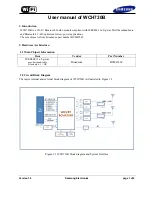
NINA-B4 series - System integration manual
UBX-19052230 - R06
Design-in
Page 26 of 45
C1-Public
☞
For the definition of integral antenna, removable antenna, antenna port, and the device
classification, refer to the ETSI EN 301 489-1. For the contact and air discharges definitions, refer
to CENELEC EN 61000 4-2.
Application
Category
Immunity level
All exposed surfaces of the radio equipment and ancillary
equipment in a representative configuration
Indirect Contact Discharge
±8 kV
Table 12: Electromagnetic Compatibility ESD immunity requirements as defined by CENELEC EN 61000-4-2, ETSI EN 301
489-1, ETSI EN 301 489-7, ETSI EN 301 489-24
NINA-B4 is manufactured with consideration to specific standards that minimize the occurrence of
ESD events; the highly automated process complies with IEC61340-5-1 (STM5.2-1999 Class M1
devices) standard [11], and designers should subsequently implement proper measures to protect
any pin that might be exposed to the end user from ESD events.
Compliance with the standard protection level specified in EN61000-4-2 is achieved by including ESD
protection close to any areas accessible by the end user.
2.7
Product testing
2.7.1
u-blox in-series production tests
With strong focus on the development of high-quality products, u-blox products are produced and
fully tested automatically in the production line. Stringent quality control processes are observed
during production, and all modules are tested using automatic test equipment (ATE).
For the purpose of quality control and future product improvement, all test and measurement data is
archived in a production database, where the results from any defective test unit is thoroughly
analyzed. A detailed test report for each module can be generated from the production data.
The following tests are performed during production:
•
Digital self-test (software download, MAC address programming)
•
Measurement of voltages and currents
•
Functional tests
•
Digital I/O tests
•
Measurement of RF characteristics in all supported bands (such as receiver RSSI calibration,
frequency tuning of the reference clock, calibration of transmitter power levels, and so on.
Figure 10 shows the typical automatic test equipment (ATE) used in a production line.
Figure 11: Automatic test equipment for module testing
















































